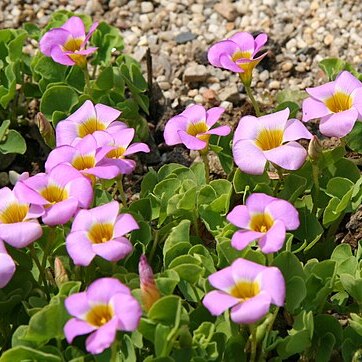Perennial herb, stemless; bulb narrowly ovoid or ovoid, attenuate at the base and apex, 1–3 cm long, tunics dark brown, hard, sometimes prominently veined, usually narrowly keeled along the midrib; bulbils absent. Plants glabrous or almost glabrous, hairs if present, simple, eglandular or glandular only on ovary and style. Leaves crowded at apex of rhizome, palmately trifoliolate; petiole dilated into membranous and often ciliate stipule-like wings at the base (at least in the outer petioles), glabrous; leaflets sessile, the medial broadly obcordate, tapering at the base, the lateral obliquely rounded, 3–7 mm long, 5–10 mm wide, rounded or sometimes emarginate, green on both sides or red on lower surface (Australian plants), glabrous above, hollow-dotted on both surfaces when dry, ecallose or with few or many small calli along the upper margin, glabrous, rarely sparsely ciliate on margins. Inflorescences basal, 1-flowered; peduncles 1–10 cm long, much longer than the leaves. Bracts situated just below the calyx, linear-subulate, 1.8–2.7 mm long, calli absent. Sepals linear-oblong or lanceolate-oblong, obtuse, 5–8 mm long, sometimes ciliate or penicillate, often purpurascent along margins, with 2–4 apical apical calli. Petals cuneate, 10–30 mm long, white (plants in Australia) or pink, pale yellow at base. Stamens at 2 levels; filaments edentate or slightly gibbose, glabrous. Ovary usually glandular-pilose on the upper half. Styles glandular near apex. Capsules not developed in Australia.
Acaulescent, mostly glabrous geophyte, 40-140 mm tall. Bulb tunics hard, conspicuously nerved and narrowly keeled, dark brown. Leaves with winged petioles near base at least in some, leaflets succulent, cuneate-suborbicular, with large epidermal cells, sometimes ciliate. Flowers 1 per peduncle with alternate bracts near calyx, white, lilac or pink, with a yellow tube, often present before leaves.
Stemless, perennial herb, up to 120 mm high. Tunics hard, sometimes prominently nerved. Leaflets broadly obovate, 3-7 x 5-10 mm, apex slightly bilobed, ecallose or with small black calli. Flowers: peduncle 1-flowered; sepals usually with 2 (rarely more) apical calli, obtuse, glabrous; corolla white, rosy or violaceous with yellow tube, 15-30 mm long; Oct.-Apr.
Stemless herb, up to 120 mm tall. Bulb ovoid. Leaves ecallose or with very few small black calli. Sepals usually with 2 (rarely more) apical calli, obtuse. Tube half the length of corolla. Flowers white, rosy or violaceous with yellow tube.
Acaulescent geophyte, up to 0.12 m high. Bulbs oval, shallow, dark brown. Leaves trifoliolate, fleshy, leaflets cuneate to rounded, with swollen epidermal cells. Flowers white, lilac or pink with yellow tube. Flowering time Nov.-May.
Acaulescent geophyte with shallow bulb. Leaves trifoliolate, succulent, leaflets cuneate-suborbicular, with large epidermal cells. Flowers white, lilac or pink with yellow tube.

